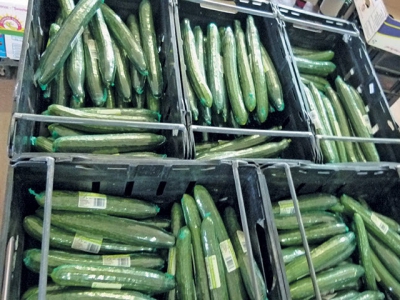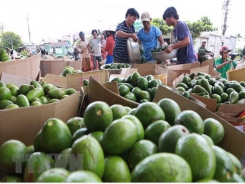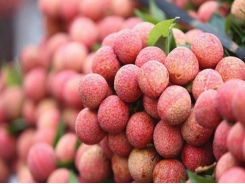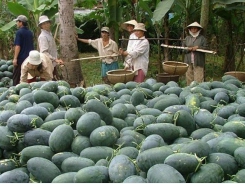Cucumber farming: volume and quality trump shrinking margins

Over the past 15 years, Alan and Russell Heger have grown their farming operation into a major supplier of cucumbers in the Eastern Cape. Grant Hollins spoke to this father-and-son team about their successes, as well as the challenges they face in trying to grow the business.
An on-site packaging facility lowers operating costs. Once built, this gave Springveg the flexibility needed to secure two major supermarket chain contracts. Cucumbers are sorted and packaged directly after picking and are usually delivered on the same day.
Springveg Farms is one of the three largest cucumber producers in the Eastern Cape. It supplies supermarket chains and markets across the country with between 50 000 and 60 000 cucumbers of the Rijk Zwaan varieties every week.
Volumes can spike to over 100 000 cucumbers per week during the Christmas period.
Owned and operated by father-and-son team, Alan and Russell Heger, the operation was first a tomato tunnel-farming enterprise more than 20 years ago.
Cucumber cultivation was gradually incorporated, which allowed for tighter control over marketing and packaging.
Since then, the operation has steadily grown, and today employs more than 70 workers who tend up to 9 000 plants under 4,5ha of drip-fertigated tunnels. However, while the Hegers are optimistic about their future growth, they are concerned that a lack of locally registered products and a weakening rand will make it difficult to maintain profit margins.
A son of a farming family near East London, Alan did not go directly into farming after completing school, despite his love of all things agricultural.
Instead, he qualified as an electrician. In 1992, while working as an electrical inspector, he bought Springveg Farm to begin farming part-time.
“My heart was always in farming, so when the opportunity came along to buy this place I had to get involved,” he says. “But there was only a small farmhouse, a chicken coop and a lot of bananas here.”
Alan improved the farm’s infrastructure, and after farming open fields for a few years, erected a number of tunnels to grow tomatoes hydroponically. In 2002, he grew cucumber plants as an experiment, and after their success began farming both cucumbers and tomatoes.
A few years later, aged 50, he took early retirement and began farming full-time.
At his father’s insistence, Russell did not go directly into farming after completing his schooling, and acquired a trade instead.
“I qualified as a diesel mechanic and worked for Datsun Nissan in East London,” he recalls.
“My dad wanted me to work for a boss before coming into the business. It was good and helped me appreciate the responsibility and dedication needed to run the business effectively.”
After Russell joined Alan in 2001, they expanded cucumber production as demand grew, and began phasing out tomato production.
In 2012, they built an on-farm packing facility and abandoned tomato production to specialise in cucumbers.
Having their own packing facility to sort, grade and package for collection on the same day reduced operating costs and provided the flexibility needed to secure consistent orders from two of South Africa’s largest supermarket chains, Spar and Shoprite.
“The overheads were a bit better and we could market directly to the supermarket chains,” says Alan.
“We supply Spar in the Eastern and Western Cape, and Shoprite in the Eastern Cape and KwaZulu-Natal, and consistently produce high volumes of top-quality cucumbers.”
Irrigation and staff
Approximately 9 000 plants are cultivated in drip-fertigated tunnels covering 4,5ha. The tunnels range in size from 2 500m2 to 5 000m2, but on average 500 plants are planted per 2 500m2, with wood shavings for mulch.
The operation is water-intensive, using an average of between 250 000ℓ and 300 000ℓ a day. Springveg still uses manually operated sprinklers.
“It’s an old, primitive system,” says Russell. “We’d love one of the fancy, fully-automated systems like those designed by Netafim, but our system still works well and the new ones are very pricey.”
To ensure that the operation consistently produces the required volumes, Russell and Alan employ two farm managers, a packhouse manager, a maintenance manager, two office personnel and 65 other permanent staff members.
Depending on production estimates, this number often swells to more than 100, depending on production estimates. The supermarket chains place their orders well in advance, allowing Russell to plan ahead for staffing requirements.
Supplying two major supermarket chains has also had a major impact on production methods and practices. Spar and Shoprite require detailed records to be kept to provide full traceability of every cucumber bought at their outlets.
Russell says that keeping meticulous records is an important part of the guaranteed quality that supermarket customers expect. “We keep detailed records and are audited each year by GlobalGap, which is an international standards’ authority,” he says.
“It’s a full-time process, but having that kind of traceability is similar to providing a guarantee of quality.”
Russell is particular about what pesticides he uses in cultivation. This is not just because the supermarket chains require that only products registered specifically for cucumbers be used, but because he believes in producing his cucumbers as organically as possible.
Rather than routine spraying against pests, he monitors the plants and sprays only when absolutely necessary. Even then, he prefers to use biological products.
“We’re very restricted in what products we can use, but I spray as little as possible to keep the cucumbers as chemical-free as possible,” he says.
“We’ve found the predatory mites and biological products to be very successful. Ultimately, I think the future is moving away from chemicals in favour of biological products.”
Unfortunately, Alan and Russell source most of these products from abroad as few are available in South Africa, and so a weakening rand affects their operating costs and profit margins.
“We’re basically buying in dollars and euros but selling in rands so when the rand drops we feel it,” says Russell. “The margins are so small that it has become a volume game. We need to keep getting bigger just to maintain the same margins.”
The cost of expansion
Growth will not be easy for Springveg, however. With its high water usage and no river frontage, new dams would need to be applied for and built.
The water in the area is also too saline and needs to be treated before use in the fertigation system, so more settlement tanks would be necessary.
In addition, the farm experiences frequent strong winds so Alan and Russell use sturdier greenhouses with thicker plastic and stronger frames, which are more expensive.
“We use Vent-Tech greenhouses,” says Alan. “The shape of the roof makes them the strongest against the wind. They’re more expensive than regular ones. We also insure our tunnels, but with a five-year declining scale, it only really pays if you need to replace the plastic in the first year.”
Russell estimates that setting up a fully functioning tunnel with fertigation would cost between R2,5 million and R3,5 million, but could be even more expensive due to site preparation costs.
“The rock here is dolerite red stone and we had to blast four times to erect these greenhouses, so it might work out too expensive to expand in the end,” says Alan.
“But in farming there are always risks, and things like crop failures can happen to anyone at any time, so we try to plan as much as possible and just continue to focus on producing top-quality produce.”
Có thể bạn quan tâm
Phần mềm

Phối trộn thức ăn chăn nuôi

Pha dung dịch thủy canh

Định mức cho tôm ăn

Phối trộn phân bón NPK

Xác định tỷ lệ tôm sống

Chuyển đổi đơn vị phân bón

Xác định công suất sục khí

Chuyển đổi đơn vị tôm

Tính diện tích nhà kính

Tính thể tích ao hồ



 Rice production in Vietnam's Mekong Delta took wrong…
Rice production in Vietnam's Mekong Delta took wrong…  Fruit exports: China changes rules, Vietnam changes strategy
Fruit exports: China changes rules, Vietnam changes strategy